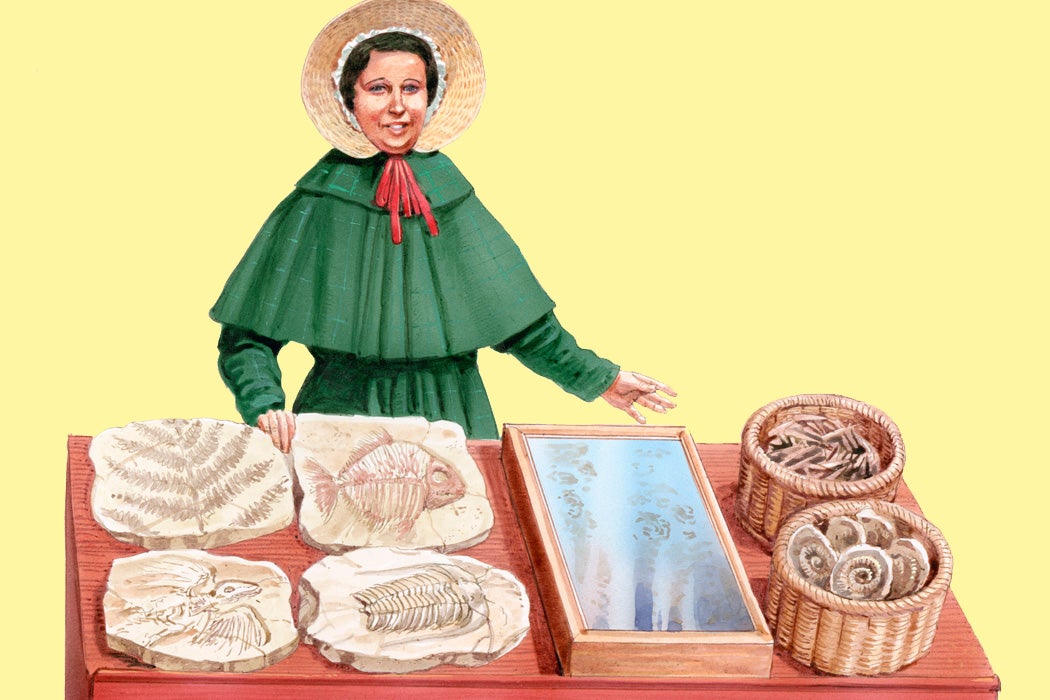During this Women’s History Month, JSTOR Daily features female scientists who transgressed boundaries to work in the natural sciences.
In the early 1800s, visitors to the English coastal town of Lyme Regis may have been stopped by a curious sight—a young lady climbing the steep cliffs. Dressed in a petticoat and bonnet, she held a hammer in her hand, chiseling things out of the cliffs.
The lady’s name was Mary Anning, and she was one of the first female fossilists—what we would now call a paleontologist. Anning was looking for remains of prehistoric creatures in the cliffs of Lyme Regis, which harbor marine fossil beds from the Jurassic period.
Anning inherited her interest in bone collecting from her father. Also a fossil collector, he unearthed the “curiosities,” which he then polished and sold to the tourists visiting the area. He died young, and Mary, along with her mother and brother, had to continue their fossil business to survive. For Anning, however, fossil hunting was more than a way to make ends meet. Over time, she became an expert in describing and classifying fossils.
Audio brought to you by curio.io
This was not an obvious career path for a woman of her era. Throughout history, women have had to overcome numerous barriers in their pursuit of scientific disciplines. But for those interested in natural sciences, the bar was even higher. Unlike in more traditional fields like nursing or midwifery where women operated within the secure confines of homes and estates, pursuing field sciences meant venturing outdoors to all the hazards it harbored—from natural perils to man-made dangers.
“Nursing historically has fit with traditional gender expectations for women and their role as caregivers,” says Jenna Tonn, visiting assistant professor at Boston College. Tonn’s research focuses on the history of women and gender in modern science. “Many women had their medicinal gardens and they were in charge of making medicines to treat their family.” But pursuing science outside of the socially-accepted norms was more difficult. Even women’s fashion at the time wasn’t conducive to outdoor exploration. Corsets made bending difficult. Puffy bloated petticoats were a nuisance. Fluffy bonnets restricted visibility. Ankle boots weren’t made for climbing precipices—and especially not the crumbling Lyme Regis’s reefs, known for falling rocks and sudden mudslides. And yet, Mary excelled at finding fossils and recovering them from the crumbling cliffs.
Anning made several important paleontological discoveries. In 1812, she and her brother Joseph unearthed a nearly-complete skeleton of a prehistoric marine reptile that looked like a cross between a dolphin and a lizard. Henry Hoste Henley, Lord of the Manor of Colway, bought the skeleton and sent it to the then-new London Museum, where it quickly became one of the most popular items, inspiring learned men to debate whether it had been a fish, crocodile, or a “lizard porpoise.” Today the creature is classified as the ichthyosaur, which roamed the seas for 150 million years.

In December 1823, Anning dug up another ancient swimming reptile that had a body “shaped like a turtle’s, but without a shell,” with a tiny head and a thin neck that was as long as the rest of the body. The Geological Society of London called it a “magnificent specimen.” It was later dubbed the plesiosaurus.
Five years later, Anning made another great discovery. She found the first skeleton of a pterosaur or the “winged-lizard.” The Geological Society described it as an “unknown species. . .a monster resembling nothing that ever been seen or heard-of upon earth.” The creature was so unlike anything previously found that it made waves among the fossilists. French naturalist and zoologist Georges Cuvier, who is often called the founding father of paleontology, wrote that “of all the ancient beings which have been discovered, these were undeniably the most extraordinary, and those which, if one could see them alive, would seem the most unlike anything.”
But perhaps Anning’s most interesting discovery was a creature that looked like a cross between a reptile and a bird. After debating for four years, scholars finally deemed it a fish, calling it Squaloraja—a transitional animal between sharks and rays. But when Anning dissected a modern ray, she realized her find was a creature of an entirely different species. “It is quite unique, analogous to nothing,” she wrote—and after quarreling amongst themselves, the best scientific minds of the time finally agreed with her.
Once a Week
More than once, Anning escaped a narrow death from the falling rocks or surging waves. In one accident, an avalanche of collapsing rocks crushed her dog, missing Anning by a miracle. But nothing could stop her digging. By the time she died in 1847, she had found hundreds, if not thousands, of prehistoric bones, advancing human knowledge of natural history.
Tonn says that Anning’s contributions to the field of paleontology may have been even greater than we know. Unlike gentlewomen of a higher societal statue, who had better resources and access to books and educational materials, Anning came from a working-class family. While Mary Somerset, the British botanist who preserved her life-long efforts in a twelve-volume herbarium, lived comfortably as a duchess, Anning had to make a living. She therefore sold most of the fossils she found, and while many of her specimens ultimately landed at museums or private collections, her name was rarely, if ever, included on the specimen lists. For this reason, according to Tonn, “it’s much harder to reconstruct her contribution to the field.”







